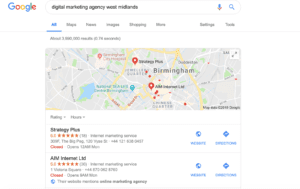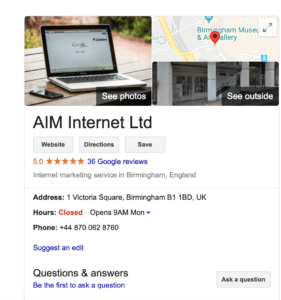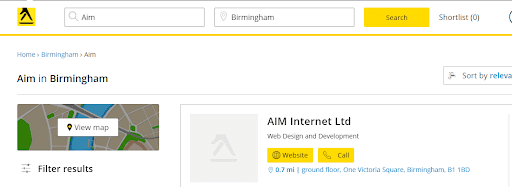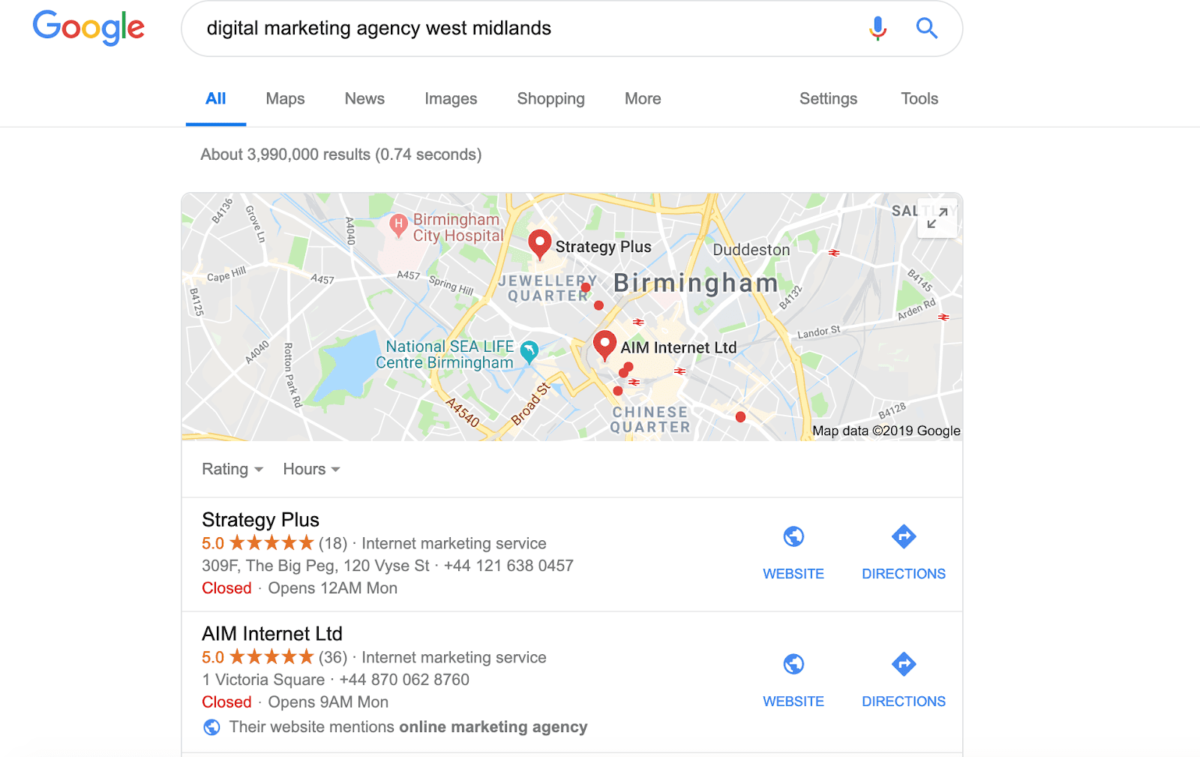The Local Google 3-Pack is the ultimate goal for any local business. Having your business feature in the first 3 results in Google search engine results page for a keyword is far more valuable and cost effective than any paid marketing campaign. Listing in the Local 3-Pack speaks volumes for your brands reputation and performance. It creates a relationship of trust between you and the searcher when they’re looking for a business that can deliver on their needs.
What is Google 3-Pack?
Google 3-pack (also known as Google’s Local 3-Pack) came into play when Google started featuring Google Map results with the leading local search results. This quickly became recognised as a good move, and Google named it the Local Pack. Originally, this was 7 local businesses relevant to the search terms entered by users. After a while, and after some extensive analysis this was reduced to 3 local businesses. This is how it still appears today.
The Local 3-Pack offers your business the most visibility in initial search results by location.

How to get your business noticed on the map.
Contact Us
Ranking a competitive keyword in the Google 3-Pack can be a scary prospect, especially if the digital space is not your natural habitat.
However, done right, it can be a very successful platform for the success of your business.
Where to start and how to get it right?
You’ll find everything you need to get started and maximise your chances of being featured in Google Maps 3-Pack right here. It’s not something that will happen overnight but the return is certainly worth the investment of your time. The key to success is not to try and cut corners with this. Stick to the rules and you’ll be able to use Google 3-pack to benefit your business long-term.
Here’s what you need to do:
Step 1: Verify and optimise your GMB listing
Lots of research has now been completed on this. In addition, the general consensus is that Google My Business signals are grouped as the most important factor when it comes to Local 3-Pack ranking. According to Moz Lab, Google My Business signals are the most important ranking factor (over 25%) when it comes to Local Pack/Finder Ranking Factors.
One of the very first (and most important) steps you should take is to make sure that the GMB listing of your listing is verified. This is super easy so there’s no excuse – all you need to do is follow this link and simply add or claim your business on Google Maps. This will be a lot easier from a desktop computer so try and avoid using your phone for this step. This allows you control of how your business features when appearing in Google search and allows you to modify information to maximise your results.
 Once this step is complete, and your GMB listing is setup, you can begin to optimise for maximum benefits.
Once this step is complete, and your GMB listing is setup, you can begin to optimise for maximum benefits.
Here are a few things you can do to get your Local 3-Pack ranking heading in the right direction:
- Positive and recent reviews go a long way to secure you a good position in your Local 3-Pack ranking. Ensuring as much completeness and engagement as possible with your GMB page is a crucial step of optimising for Google 3-Pack. You should always respond to reviews, good or bad in order to send the right GMB signals to Google.
- GMB posts are a great way of encouraging more engagement and leads from potential customers already interested in a particular brand. This also helps with link building which is good for Google’s algorithm.
- It’s also important to rewrite your location pages to optimise your GMB. If you have a GMB listing with multiple locations, you can improve your rankings by rewriting the location page for each of the listings, which will also make you eligible to rank for additional queries.
- You should also keep a close eye out for spam competitors that are ranking above you. Make sure you report any GMB listing spam, review spam and edited listings that are keyword stuffing – these are all effective tactics and will boost your own ranking.
Step 2: Link building
Just as link building is important for general SEO optimisation, link building is a very effective way to optimise for the Local 3-Pack ranking. Google has the power and resources to analyse all data related to your business and website. This means, the more authoritative and trusted your business website is, the better your chances of being featured in the Local 3-Pack are.
Related:How to Create an Internal Linking Strategy Perfect For SEO
A key thing to remember when it comes to the Local Google 3-Pack is your website is still an essential tool for maximising your ranking. One of the key metrics Google analyses when generating the Local 3-Pack schema is the inbound link authority of the business, so keeping this up to date is imperative.
In an ideal situation you will have plenty of high authoritative links to and from your website. Although link building can be quite complex, we have put together a few of the basic elements the search algorithms are analysing when generating the Local 3-Pack.
Top Basic Elements:
- Inbound link authority – as mentioned above, link authority is one of the most important link-building factors because it tells Google and its search algorithms that other people find your website and its content valuable.
- Inbound links from other locally relevant websites – links from other local authoritative sources is another great way to up your ranking. Google assigns local relevance to links from nearby sources, so you need to find ways to link your business to the most authoritative websites in your area.
- Link quality – as previously mentioned, the better the link quality, the better this will be for your ranking in both generic results and local searches. Keeping this in mind, a great way to optimise your ranking is with quality content. Guest blogging and affiliate networking strategies are a brilliant way to build a catalogue of quality content whilst also generating large numbers of quality backlinks if you don’t already have a catalogue of content on your site.
- Link diversity – since the Google Penguin algorithm update, search engines have also included back links in their analysis and ranking process. This means to stay relevant in the eyes of Google, it’s important to build links organically from a wide variety of sources.
Step 3: Local citation building
A local citation means having another website reference your business, name, address, contact details etc. Citations are regarded highly by Google so it’s important to get yourself listed where possible. Citation signals (NAP consistency, citation volume, etc.) account for more than 10% so it’s not something to be overlooked. Great examples of websites that help boost your ranking are TripAdvisor or Yell, they simply need to display your your business NAP (Name, Address, Business).

As a general rule, the more times your business / website is referenced elsewhere, the more authoritative and credible your business will come across to Google.
Here are a few things to consider when it comes to local citation building:
- Citation consistency – it’s really important that once you have built up your citation portfolio that each listing is consistent with the next. If your business NAP differs from one listing to another it reflects badly in the eyes of Google and could result in your website being labelled spammy, which is not good for climbing the ranks of Google 3-Pack.
- Citation authority – just as inbound links from trusted websites are beneficial to your website, citations from authoritative sites will help boost your local ranking. As mentioned above, building citations from high ranking and trusted websites such as Yell and Tripadvisor are a great source of local ranking success.
- Citation relevance – relevancy is another factor you need to consider during this process. Relevant domains in your geographic area (local newspapers, blogs, local directories, etc.) will earn you brownie points in your local ranking.
Step 4: Ensure your site is mobile-friendly
It will come as no surprise that that your site needs to be mobile responsive for it to stand any kind of chance in today’s digital world. A huge 4 out of 5 people searching for local information are doing so from their mobile phone. People expect instant results, if your website limits them they will move swiftly onto a competitor. This is only increasing as the younger generations make their way through so our advice is to make your website mobile friendly as soon as possible. A good test to see how your website is fairing is by using Google’s mobile friendly test.
There are a few things to bear in mind when creating the optimal website for your mobile users:
- Page speed – this is extremely important for both your users and for Google’s mobile bots. Google will penalise any site that has a slow page load time and users are not forgiving if they have to wait. A few ways to optimise your page loading times are browser caching, reducing redirects, minifying code, optimising images, and reducing side bar ads etc. For an in depth understanding read our article on how page speed impacts your SEO.
- Make sure your site isn’t blocking CSS and JavaScript – crawl bot technology means if information is blocked from it, the site will be penalised. CSS, JavaScript, and images are all key fundamentals that will help Google bots digest and rank your site accordingly.
- Pull in the experts or use a mobile optimised theme – your site needs to offer the user the best experience possible, this means ensuring the foundations of the site are solid.
- Try to avoid Flash – most mobile browsers no longer support Flash, so if you can, avoid it. If you really want to include special effects then we recommend using HTML5 instead. However, bear in mind that this will impact your page load time.
- Use a responsive web design – a responsive web design will automatically adapt to the needs of the user, it will deliver the same content but in the format that’s required of it, whether it’s mobile, desktop or any other portable device.
Phase 5: Content is King
The content on your website is just as important for your Local 3-Pack ranking as it is for your general SEO ranking, so make sure it’s relevant and informative. The inclusion of keywords is essential but remember not to keyword stuff and to write for your user, not Google. As always, content is King.
Here are a few things Google take note of when they’re analysing your sites on-page content:
- Length of content – in the eyes of Google the length of content is an indicator of the quality of content. But remember, Google is smart so the content still needs to be relevant and authoritative not just written for the sake of being written.
- Locally relevant content – to feature in the Local Google 3-Pack it’s important that your content has local relevance and references to the areas surrounding your business. A great way of doing this is by using in-content links to local sites or references to the local areas of interest.
Phase 6: Using a NAP footer on your website
Using a specific schema markup will help Google’s bots crawl your site and understand its structure. This is not essential but every little helps when trying to feature in your Local 3-Pack. A very easy way of achieving this is by including a NAP (name, address and phone number) in the footer of your website.
This must be consistent with your GMB profile and you need to remember to load this into the structured data Schema, this will significantly increase your chances of appearing inside the Local 3-Pack.
Google’s Structured Data Markup Helper can help you create and implement this.
Step 7: Reviews reviews reviews
Reviews are worth their weight in gold when it comes to your websites online ranking. However, it’s not just about how many five star reviews you have, it’s also about how you manage those reviews. As well as, interact with your reviewers (both positive and negative). Reputation management is extremely important and shouldn’t be overlooked.

Here are a few elements that you should bear in mind when focusing on reviews:
- Responding to reviews – make it your mission to respond to all reviews, both positive and negative. This not only encourages trust between you and your customers but also sends the right signals to Google.
- Encourage keyword reviews – obviously you can’t control what your customers have to say, but try and encourage them to leave reviews about the specific product or services they’ve purchased as opposed to generic non-specific reviews. Google will look fondly upon this.
- Purchase follow-ups – a great way of encouraging product specific reviews is as part of your follow service. This can be done easily through a CRM and can offer links to key review websites including Google.
- Don’t ignore bad reviews – as previously mentioned, it’s important to answer all reviews, especially bad ones. A bad experience can be undone by excellent customer service and will be reflected positively by Google.
Step 8: Social proofing
Social proofing is essential on your journey to being featured in the Local 3-Pack. Google will analyse your social signals before it ranks your business.
Generally, the more people that engage and talk about your business via social media or other platforms, the better the local SEO.
Here are a few social signals that Google looks out for when ranking local search:
- Social media growth – a steady social media incline, with regards to interaction, following and influence is a big positive when Google’s algorithm is ranking a local business.
- User influence – the more shares, likes, retweets, and brand mentions your business can get the better when it comes to local ranking, so make sure you’re maximising your opportunities when it comes to your social presence.
- Consistent messaging and branding – make sure your branding; tone of voice and posting schedule is consistent.
- Consistent brand information – don’t forget the importance of ensuring all of your brand information is consistent and point towards the right NAP.
- Customer engagement – as previously mentioned, it’s important to ensure all reviews are replied to, this includes social media reviews and feedback.
It’s important you are doing this across multiple platforms. We all know Facebook, but there are some great other options such a pinterest, Instagram and Twitter. The key is discovering which platform will work best for your business and audience. Just make sure your business information is consistent across every platform.
Time to Get Started
Now it’s time to put what you have learnt to good use. Remember, this is just a general guide and it’s important to do your own research when it comes to what will work best for your business when trying to rank in your Local Google 3-Pack.
At AIM Internet we are more than just a digital agency, we want to work alongside you to help improve your business and we have vast experience with different industries and achieving SEO goals. We strive to build lasting relationships with our clients and act as an extension of your business to bring overall digital success. We work tirelessly to help maximise your digital marketing efforts.
To find out more about ranking in your Google Local 3-Pack call Mike on 08700628760 or visit our website.
If you have found this guide helpful, you may wish to read our previous article about Trade Shows.

